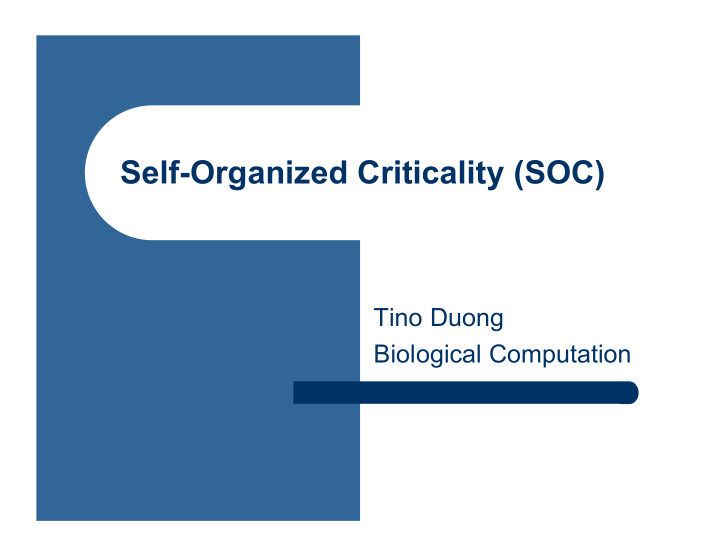



Self-Organized Criticality (SOC) Tino Duong Biological Computation
Agenda l Introduction l Background material l Self-Organized Criticality Defined l Examples in Nature l Experiments l Conclusion
SOC in a Nutshell l Is the attempt to explain the occurrence of complex phenomena
Background Material
What is a System? l A group of components functioning as a whole
Obey the Law! l Single components in a system are governed by rules that dictate how the component interacts with others
System in Balance l Predictable l States of equilibrium – Stable, small disturbances in system have only local impact
Systems in Chaos l Unpredictable l Boring
Example Chaos: White Noise
Edge of Chaos
Emergent Complexity
Self-Organized Criticality
Self-Organized Criticality: Defined l Self-Organized Criticality can be considered as a characteristic state of criticality which is formed by self-organization in a long transient period at the border of stability and chaos
Characteristics l Open dissipative systems l The components in the system are governed by simple rules
Characteristics (continued) l Thresholds exists within the system l Pressure builds in the system until it exceeds threshold
Characteristics (Continued) l Naturally Progresses towards critical state l Small agitations in system can lead to system effects called avalanches l This happens regardless of the initial state of the system
Domino Effect: System wide events l The same perturbation may lead to small avalanches up to system wide avalanches
Example: Domino Effect By: Bak [1]
Characteristics (continued) l Power Law l Events in the system follow a simple power law
Power Law: graphed i) ii)
Characteristics (continued) l Most changes occurs through catastrophic event rather than a gradual change l Punctuations, large catastrophic events that effect the entire system
How did they come up with this?
Nature can be viewed as a system l It has many individual components working together l Each component is governed by laws l e.g, basic laws of physics
Nature is full of complexity l Gutenberg-Richter Law l Fractals l 1-over-f noise
Earthquake distribution By: Bak [1]
Gutenberg-Richter Law By: Bak [1]
Fractals: l Geometric structures with features of all length scales (e.g. scale free) l Ubiquitous in nature l Snowflakes l Coast lines
Fractal: Coast of Norway By: Bak [1]
Log (Length) Vs. Log (box size) By: Bak [1]
1/F Noise By: Bak [1]
1/f noise has interesting patterns 1/f Noise White Noise
Can SOC be the common link? l Ubiquitous phenomena l No self-tuning l Must be self-organized l Is there some underlying link
Experimental Models
Sand Pile Model l An MxN grid Z l Energy enters the model by randomly adding sand to the model l We want to measure the avalanches caused by adding sand to the model
Example Sand pile grid l Grey border represents the edge of the pile l Each cell, represents a column of sand
Model Rules l Drop a single grain of sand at a random location on the grid l Random (x,y) l Update model at that point: Z(x,y) ‡ Z(x,y)+1 l If Z(x,y) > Threshold, spark an avalanche l Threshold = 3
Adding Sand to pile l Chose Random (x,y) position on grid l Increment that cell l Z(x,y) ‡ Z(x,y)+1 l Number of sand grains indicated by colour code By: Maslov [6]
Avalanches l When threshold has been exceeded, an avalanche occurs l If Z(x,y) > 3 l Z(x,y) ‡ Z(x,y) – 4 l Z(x+-1,y) ‡ Z(x+-1,y) +1 l Z(x,y) ‡ Z(x,y+-1) +1 By: Maslov [6]
Before and After Before After
Domino Effect l Avalanches may propagate By: Bak [1]
DEMO: By Sergei Maslov Sandpile Applet http://cmth.phy.bnl.gov/~maslov/Sandpile.htm
Observances l Transient/stable phase l Progresses towards Critical phase l At which avalanches of all sizes and durations l Critical state was robust l Various initial states. Random, not random l Measured events follow the desired Power Law
Size Distribution of Avalanches By: Bak [1]
Sandpile: Model Variations l Rotating Drum l Done by Heinrich Jaeger l Sand pile forms along the outside of the drum Rotating Drum
Other applications l Evolution l Mass Extinction l Stock Market Prices l The Brain
Conclusion l Shortfalls l Does not explain why or how things self-organize into the critical state l Cannot mathematically prove that systems follow the power law l Benefits l Gives us a new way of looking at old problems
References: l [1] P. Bak, How Nature Works. Springer -Verlag, NY, 1986. l [2] H.J.Jensen. Self-Organized Criticality – Emergent Complex Behavior in Physical and Biological Systems. Cambridge University Press, NY, 1998. l [3] T. Krink, R. Tomsen. Self-Organized Criticality and Mass Extinction in Evolutionary Algorithms. Proc. IEEE int. Conf, on Evolutionary Computing 2001: 1155-1161. l [4] P.Bak, C. Tang, K. WiesenFeld. Self-Organized Criticality: An Explanation of 1/f Noise. Physical Review Letters. Volume 59, Number 4, July 1987.
References Continued l [5] P.Bak. C. Tang. Kurt Wiesenfeld. Self-Organized Criticality. A Physical Review. Volume 38, Number 1. July 1988. l [6]S. Maslov. Simple Model of a limit order-driven market. Physica A. Volume 278, pg 571-578. 2000. l [7] P.Bak. Website: http://cmth.phy.bnl.gov/~maslov/Sandpile.htm. Downloaded on March 15 th 2003. l [8] Website: http://platon.ee.duth.gr/~soeist7t/Lessons/lessons4.htm. Downloaded March 3 rd 2003.
Questions ?
Recommend
More recommend